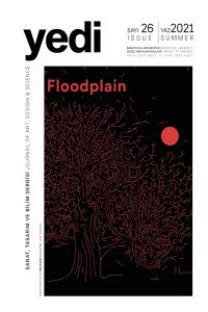Metropolis Filmi: Aydınlanmanın Diyalektiği, Modernite, Mit ve Modern Mimari
Metropolis, Fritz Lang, Theodor Adorno, Max Horkheimer, Fütürizm, Modern Mimari, Ütopya, Distopya
Metropolis Revisited: Dialectic of Enlightenment, Modernity and Architectural Modernizm
Metropolis, Fritz Lang, Theodor Adorno, Max Horkheimer, Futurism, Architectural Modernism, Utopia, Distopia,
___
- Abrams, Jerold. J. (2007). “The Dialectic of Enlightenment in Metropolis” Philosohy of Popular Culture: Philosophy of Science Fiction Film, ed. Sanders, Lexington, KY: University of Kentucky, s: 153-170.
- Adorno, Theodor, W. Horkheimer, Max. (2010). Aydınlanmanın Diyalektiği, çev. Elif Öztarhan, Nihat Ülner, İstanbul: Kabalcı Yayınevi.
- Albrecht, Donald (1996). “New York, Old York: The Rise and Fall of a Celluloid City”. in Film Architecture: Set Designs from Metropolis to Blade Runner, (ed) D. Neumann, New York, Munich: Prestel- Verlag, s: 39-47.
- Balla Giaccomo, Depero Fortunato (2001). “The Futurist Reconstruction of the Universe.1915. Futurist Manifestoes, ed. Umbro Apollonio, Thames and Hudson, s: 197-200.
- Banham, Reyner (1980). Theory and Design in the First Machine Age, Cambridge: MIT Press.
- Baudrillard, Jean (1994). Simulacra and Simulation, trans. S. F. Glaser, Ann Arbor: University of Michigan Press.
- Coleman, Nathaniel (2010). “The Peculiar Adventure of Utopia: Discourses of Modern Architecture in the 20th Century and Today”. International Society for the Philosophy of Architecture. http://isparchitecture.wordpress.com. (17.11.2012)
- Colquhoun, Alan (1990) Mimari Eleştiri Yazıları, çev. A. Cengizkan, Ankara: Ş.V.M.V. Yayınları.
- Dostoğlu, N. T. (2001) “Ütopya, Kent ve Mimarlık Üzerine Düşünceler”. Arredamento Mimarlık, 5: 73-76.
- Jacobsen, Wolfgang, Sudendorf, Werner (2000). Metropolis: A Cinematic Laboratory for Modern Architecture, Stutgard, London: Axel Menges.
- Jameson, Fredric (2005). Archaeologies of the future: The desire called utopia and other science fictions, London: Verso.
- Kaes, Anton (1993). “Metropolis: City, Cinema, Modernity”. Expressionist Utopias: Paradise, Metropolis, Architectural Fantasy, ed.Timothy O. Benson, Los Angeles: Los Angeles County Museum of Art, s: 146-165.
- ______ (2009). Shell Shock Cinema: Weimar Culture and the Wounds of War, Princeton: Princeton University Press.
- Le Corbusier, (2010). Bir Mimarlığa Doğru, çev. Serpil Merzi, İstanbul: YKY.
- Milner, A. (2009). “Changing the Climate: The Politics of Dystopia”. Continuum: Journal of Media & Cultural Studies. 23: 827-838.
- More, Thomas (2001). Utopia, trans. C. Miller, New Haven: Yale University Press.
- Neumann, Dietrich (1996). “Before and After Metropolis: Film and Architecture in Search of the Modern City”. Film Architecture: Set Designs from Metropolis to Blade Runner, ed. Dietrich Neumann, New York, Munich: Prestel-Verlag, s: 33-38.
- Roberts, Ian (2004). “Caligari Revisited: Circles, Cycles and Counter- Revolution in Robert Wiene’s Das Cabinet Des Dr. Caligari”, German Life and Letters 57 (2): 175-187.
- Thompson, Kristin, Bordwell, David (2003). Film History: an Introduction, New York: McGraw-Hill Companies Inc.
- Vidler, Anthony (1996). “The Explosion of Space: Architecture and Filmic Imaginary”. Film Architecture: Set Designs from Metropolis to Blade Runner, ed. Dietrich Neumann, New York, Munich: Prestel-Verlag, s: 13-25. İnternet Kaynakları
- IMDB; Fritz Lang http://www.imdb.com/name/nm0000485/ (17.11.2012)
- Stanford Encyclopedia of Philosophy; Theodor W. Adorno http://plato.stanford.edu/entries/adorno/ (17.11.2012)
- Stanford Encyclopedia of Philosophy; Max Horkheimer http://plato.stanford.edu/entries/horkheimer/ (17.11.2012)
- Paralax Görsel Kültür Arşivi 006, Cook, John, J. (2000) “Sessiz Sinemanın Kinetiği: Yirminci Yüzyılın Başlarında Sinema ve Hareket İlişkisi”. Çev. O. C. Çetin. http://www.hezarfen.net/paralax/006cooktr.htm (12.06.2013) Görsel Kaynaklar
- Fotoğraf 1. Walter Gropius, Monument to the March Dead, 1921. http://en.wikipedia.org/wiki/File:Monument_to_the_March_ dead.jpg.
- Fotoğraf 2. Metropolis filminde kalbi simgeleyen dev gong (Filmden kesit).
- Fotoğraf 3. Sol: New York Kentinden görüntü http://newyorkresidence.co.uk/default_uk.aspx Sağ: Metropolis filminde kent (Filmden kesit).
- Fotoğraf 4. Sol: Metropolis filmi afişinde kent, Orta: Giacomo Balla, Speeding-Automobile, 1913. h t t p : / /w w w. s a s . u p e n n . e d u / ~ j e n g l i s h /C o u r s e s / Spring02/104/Balla_SpeedingCar1.jpg Sağ: New York University Faculty Class Web Sites, Futurism sayfası http://www.nyu.edu/classes/reichert/sem/city/futurism. html
- Fotoğraf 5. Metropolis filminde kent (Filmden kesit).
- Fotoğraf 6. Antonio Sant’Elia, Citta Nuova, 1912-1914. http://www.nyu.edu/classes/reichert/sem/city/futurism. html
- Fotoğraf 7. Metropolis filminde M-Makine ve işçiler (Filmden kesit).
- Fotoğraf 8. Rotwang, laboratuarı ve robot Maria (Filmden kesit).
- Fotoğraf 9. Sol ve Orta: Robot Maria, Yushiwara gece klübü, erkeklerin Maria’nın dansına tepkileri (Filmden kesit). Sağ: Giacomo Balla, Velocita D’Automobile + Luci, http://www.thecityreview.com/s07simp1.html
- ISSN: 1307-9840
- Başlangıç: 2007
- Yayıncı: Dokuz Eylül Üniversitesi
Antik Yunan’da Toplumsal Cinsiyet Rollerinin Temsili
Batıda Çağdaş Feminist Tiyatronun Gelişimi
Osmanlı Saray Şenliklerinden Günümüze Bir Kültür Ürünü: Nahıl
Türk Müziği İcralarının Analizi için bir MIDI Projesi
Metropolis Filmi: Aydınlanmanın Diyalektiği, Modernite, Mit ve Modern Mimari
Bonhams Müzayedelerinde Satışa Sunulmuş Bir Grup Figürlü İznik Tabağı
Oryantalist Resimlerde Türk Halıları
Elvan ÖZKAVRUK ADANIR, Berna İLERİ
